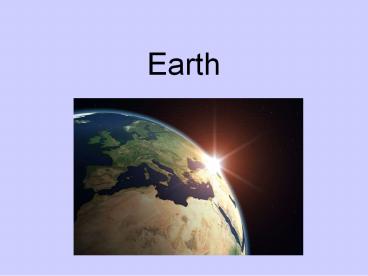Earth - PowerPoint PPT Presentation
1 / 35
Title: Earth
1
Earth
2
Physical Characteristics of Earth
- Spherical shape
- -satellite photos
- -curved shadow on moon during a lunar eclipse.
- -approaching ships rise over the horizon
3
Physical Characteristics of Earth
- 2. Rotation
- -Earth spins on its axis (an imaginary vertical
line) causing night and day. - -24 hours to rotate once on its axis
- -rotates 365 times in a year
Foucaults Pendulum shows the Earths rotation as
it swings
https//www.youtube.com/watch?vR3jr0DaV8N8
4
Physical Characteristics of Earth
- 3. Magnetic Field
- -Movement of liquid iron inside Earth and its
rotation create a magnetic field. - -Helps protect Earth from harmful CMEs from the
sun.
5
Physical Characteristics of Earth
- 4. Revolution
- -Earths yearly orbit around the sun. (365 ¼
days) - -Path is elliptical in shape.
Farthest away from sun in July
Closest to sun in January
6
What causes the seasons?
- ?
?
?
7
What do you know about the Seasons?
- Summer
- NJ-warm, longer days, June-August
- Hawaii-80s, 12 hours of light
- Alaska- up to 24 hours of light
- Australia-Dec-Feb
- Winter
- NJ-cold, longer nights, Dec-Feb
- Hawaii- 70s, 12 hrs of light
- Alaska-up to 24 hours of darkness
- Australia-June-Sept.
8
Distance from the sun does NOT cause our seasons.
- If it did, we would all feel winter in July and
summer in January. Even Hawaii would have a cold
winter!
9
Physical Characteristics of Earth
- 5. A Tilted Axis
- 23.5 tilt
- -The Earth is always tilted the same direction
during its yearly revolution around the sun.
10
(No Transcript)
11
- Sunlight strikes the hemisphere tilted towards
the sun more directly than the hemisphere tilted
away. - Summer occurs in the hemisphere tilted towards
the sun. (direct light)
Sun
12
Direct Light
- Areas receiving direct light from the Sun have a
greater amount of sunlight, therefore higher
temperatures.
13
What season is it?
Northern Hemisphere-Winter Southern
Hemisphere-Summer
Sun
14
So what causes the seasons?
- The Earths tilt causes the seasons!
http//lhsgems.org/Presentations/SSS203-820NSTA
20200920final.ppt362,35,Another Model for
Distance
15
Solstice
- The day when the sun reaches its greatest
distance north or south of the equator. - Northern Hemisphere- (opposite of S. Hemi)
- Summer solstice June 21 or 22 (longest period of
daylight of the year) - Winter solstice December 21 or 22 (shortest
period of daylight of the year)
16
The suns path across the sky is higher in the
summer and lower in the winter
http//www.newscientist.com/blogs/shortsharpscienc
e/2011/10/about-time-beer-can-freezes-ti-1.html
17
Equinox
- When the sun is directly above the Earths
equator. Daylight hours are nearly equal all
over Earth. - Neither the N. or S. Hemisphere is tilted towards
the sun. - Spring equinox-March 20 or 21
- Fall equinox-September 22 or 23
18
Seasons demos
- https//www.youtube.com/watch?vDD_8Jm5pTLk
- http//esminfo.prenhall.com/science/geoanimations/
animations/01_EarthSun_E2.html
http//spiff.rit.edu/classes/phys301/lectures/gas_
planets/Seasons_Nav.swf
19
Northern Hemisphere Solstice and Equinox positions
Seasons are opposite for the Southern Hemisphere
20
Review Quiz
21
Which diagram correctly shows Earths orbit
around the sun?
22
- Identify for the N. Hemisphere
- Summer solstice
- Winter solstice
- Fall equinox
- Spring equinox
D
Spring
C
A
Winter
Summer
B
Fall
23
How do we know the Earth is a sphere?
- -satellite photos
- -curved shadow on moon during a lunar eclipse.
- -approaching ships rise over the horizon
24
What is an axis?
- The imaginary vertical line around which the
Earth spins.
25
What does A represent? What does B represent?
- A-Revolution B-Rotation
B
A
26
How long does one complete rotation take on Earth?
- 24 hours
27
How long does one complete revolution of Earth
take?
- 365 days (1 year)
28
Why is a magnetic field important?
- It protects Earth from CMEs from the Sun
29
How do we have a magnetic field?
- The motion of the liquid metal inside Earth and
our daily rotation cause it.
30
What causes the seasons?
- TILT! TILT! TILT!
31
What season is it in the Southern Hemisphere?
- Summer-southern hemisphere is tilted towards the
sun direct light summer!
Sun
32
What type of light makes hotter temperatures?
- Direct!
33
Where is the sun during the equinox?
- Directly over the equator.
34
Whats the difference between northern and
southern hemispheres seasons?
- They are opposite!
Easter is celebrated in the fall (March or April)
Christmas (December) in Australia is warm!
35
- http//www.teach-nology.com/worksheets/science/ear
th/4/































